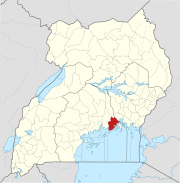Sezibwa River

The Sezibwa River is a river in Central Uganda, in East Africa. The name is derived from the Luganda phrase "sizibwa kkubo", which translates into "my path cannot be blocked".
Location
River Sezibwa is located in the southern central part of Uganda. It starts from the wetlands between Lake Victoria and Lake Kyoga, west of the Victoria Nile and flows in a general northerly direction to empty into Lake Kyoga. The source of River Sezibwa is located in Buikwe District, near the town of Ngogwe, with coordinates: Latitude:0.2700; Longitude:33.0050. River Sezibwa enters Lake Kyoga in Kayunga District, near the town of Galilaya, with coordinates: Latitude:1.3700; Longitude:32.8150. The length of River Sezibwa is approximately 150 kilometres (93 mi) from source to end. [1] Between its source in Buikwe District, but before it enters Kayunga District, the river flows through Mukono District.
Sezibwa Falls
The Sezibwa Falls are approximately 20 miles (32 km), east of Kampala, Uganda's capital, along the Kampala-Jinja Highway. The site is a Buganda Heritage Site. It is marked with an out-span of sharp-edged rocks and the magnificent sound of soothing waters flowing down the steep ridged stones. The Falls are located in Mukono District.
According to traditional legend, the two rivers named Sezibwa and its brother Bwanda, were born by a woman on her way to Kavuma Bukunja. The woman, Nakkungu Tebatuusa, whose husband was called Nsubuga Sebwaato, gave birth to twins in form of water, whereupon Sezibwa flowed west, passing many obstacles and deriving its name, while Bwanda flowed east, toward Nyenga. Many people come to the place for miracles as they believe the site has supernatural powers.
The falls are 7 metres (23 ft) high and the harmony of bird songs above the trees creates a beautiful scenery for relaxation and enjoyment. Rock climbing and bird watching are the main activities at the site. Geologists and other scientists also frequent the site. Wildlife in the surrounding forest includes bush monkeys, red-tailed monkeys and other primates and birds.[2]



